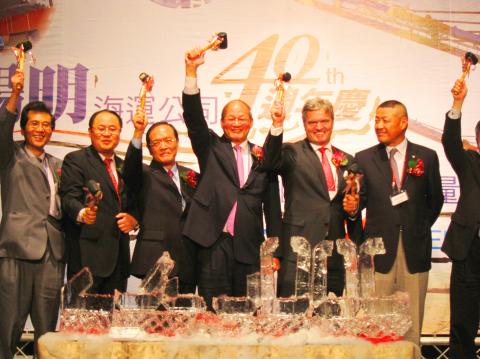Yang Ming Marine Transport Corp (陽明海運), the nation’s second-largest container shipper in terms of fleet size, expects revenue to grow about 10 percent next year on the back of rising demand driven by a mild global economic recovery, a company official said yesterday.
The container shipper also looks to be returning to the black this year, after it sold a 30 percent stake in Kao Ming Container Terminal Corp (高明貨櫃碼頭) — its container terminal operator subsidiary in Kaohsiung Harbor — to three Chinese shipping companies for US$135 million on Wednesday.
“The growing momentum in the global economy next year will be stronger than this year, further raising transport volume for container shippers,” Yang Ming chairman Frank Lu (盧峰海) told a media briefing after a ceremony celebrating the company’s 40th anniversary in Kaohsiung.

Photo: Wang Yi-hung, Taipei Times
The shipper will increasingly focus on launching more Asian routes next year to shift more capacity to countries with greater economic growth and higher demand, Lu added.
However, Yang Ming maintains a “cautiously optimistic” view on the company’s sales performance and profitability next year amid concern about the issue of oversupply, as the number of vessels planned to be delivered next year remains high.
The latest research by Alphaliner shows that container vessel orders placed by non-operating ship owners have been showing a downturn, accounting for 37.1 percent of all orders, signifying a trend of slowing oversupply in the near future.
However, a figure between 20 percent and 30 percent would be a healthier level for the container shipping sector, Lu said.
Therefore, Lu said the sector’s profitability next year still depends on major shippers’ control on capacity to maintain freight rates.
Meanwhile, Lu said he expects global crude oil prices to show a declining trend next year, as the US and Russia both plan to increase supply, with liquefied natural gas to be further developed in the near future.
This will be the other key factor affecting Yang Ming’s profitability next year, as fuel usually accounts for 25 percent to 28 percent of the company’s overall costs, he added.
Meanwhile, Lu said he expected Kaohsiung’s Kao Ming Container Terminal to see throughput volumes expand next year, after teaming up with the three Chinese companies — COSCO Pacific Ltd (中遠太平洋), China Shipping Terminal Development Co (中海碼頭發展) and China Merchants Holdings (International) Co (招商局國際).
A China Ocean Shipping Co’s (COSCO, 中遠集團) official, who participated in yesterday’s ceremony, said the company would bring in up to 2 million twenty-foot-equivalent units (TEUs) of containers to Taiwan next year through cooperation with Kao Ming.
Yang Ming posted net losses of NT$2.49 billion (US$85.5 million), or NT$0.88 per share, in the first three quarters of the year, compared with a net loss of NT$5.3 billion (NT$1.88 per share) a year ago, while consolidated revenue totaled NT$96.47 billion in the first nine months, up 9.63 percent from a year earlier, company data showed.
The company’s shares rose 1.53 percent to close at NT$13.25 in Taipei trading yesterday.

WEAKER ACTIVITY: The sharpest deterioration was seen in the electronics and optical components sector, with the production index falling 13.2 points to 44.5 Taiwan’s manufacturing sector last month contracted for a second consecutive month, with the purchasing managers’ index (PMI) slipping to 48, reflecting ongoing caution over trade uncertainties, the Chung-Hua Institution for Economic Research (CIER, 中華經濟研究院) said yesterday. The decline reflects growing caution among companies amid uncertainty surrounding US tariffs, semiconductor duties and automotive import levies, and it is also likely linked to fading front-loading activity, CIER president Lien Hsien-ming (連賢明) said. “Some clients have started shifting orders to Southeast Asian countries where tariff regimes are already clear,” Lien told a news conference. Firms across the supply chain are also lowering stock levels to mitigate

IN THE AIR: While most companies said they were committed to North American operations, some added that production and costs would depend on the outcome of a US trade probe Leading local contract electronics makers Wistron Corp (緯創), Quanta Computer Inc (廣達), Inventec Corp (英業達) and Compal Electronics Inc (仁寶) are to maintain their North American expansion plans, despite Washington’s 20 percent tariff on Taiwanese goods. Wistron said it has long maintained a presence in the US, while distributing production across Taiwan, North America, Southeast Asia and Europe. The company is in talks with customers to align capacity with their site preferences, a company official told the Taipei Times by telephone on Friday. The company is still in talks with clients over who would bear the tariff costs, with the outcome pending further

Six Taiwanese companies, including contract chipmaker Taiwan Semiconductor Manufacturing Co (TSMC, 台積電), made the 2025 Fortune Global 500 list of the world’s largest firms by revenue. In a report published by New York-based Fortune magazine on Tuesday, Hon Hai Precision Industry Co (鴻海精密), also known as Foxconn Technology Group (富士康科技集團), ranked highest among Taiwanese firms, placing 28th with revenue of US$213.69 billion. Up 60 spots from last year, TSMC rose to No. 126 with US$90.16 billion in revenue, followed by Quanta Computer Inc (廣達) at 348th, Pegatron Corp (和碩) at 461st, CPC Corp, Taiwan (台灣中油) at 494th and Wistron Corp (緯創) at

NEGOTIATIONS: Semiconductors play an outsized role in Taiwan’s industrial and economic development and are a major driver of the Taiwan-US trade imbalance With US President Donald Trump threatening to impose tariffs on semiconductors, Taiwan is expected to face a significant challenge, as information and communications technology (ICT) products account for more than 70 percent of its exports to the US, Chung-Hua Institution for Economic Research (CIER, 中華經濟研究院) president Lien Hsien-ming (連賢明) said on Friday. Compared with other countries, semiconductors play a disproportionately large role in Taiwan’s industrial and economic development, Lien said. As the sixth-largest contributor to the US trade deficit, Taiwan recorded a US$73.9 billion trade surplus with the US last year — up from US$47.8 billion in 2023 — driven by strong